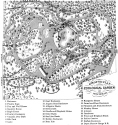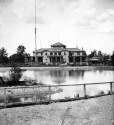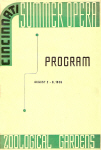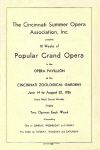The Cincinnati Zoo was founded by Andrew
Erkenbrecher, who was President of Cincinnati's first telephone company, on
September 18, 1875 thus making it the second zoo in the country. Philadelphia had opened the first zoo 14 months
earlier. There is a bust of Erkenbrecher, who died in 1885, outside of the
reptile house. His daughter Emma married the successful furrier A. E. Burkhardt
who became zoo president, and one of his sons, Albert Gano, served as zoo
treasurer.
The zoo began with 66.4 acres and 769 animals. Over the years land
was bought and sold until today there is 75 acres with 500+ species with 1,896
animals.
CINCINNATI ZOO HIGHLIGHTS
1873: At the urging of wealthy businessman
Andrew Erkenbrecher the Zoological Society of Cincinnati is incorporated.
1874: 67 Acres of Blakely Woods leased as the site for the
Cincinnati Zoo.
1875: The Zoo opens with 769 animals on display. Admission
is 25 cents. 15 cents for children.
1876: The Restaurant or Clubhouse opens.
1877: Zoo collection expands with the addition
of an Indian rhinoceros and a California sea lion exhibit.
1878: The first sea lion in captivity is born, the
first pair of giraffes acquired (Daisy and Abe).
1880: The first zoo hatching of a trumpeter swan born,
four passenger pigeons also hatched.
1882: The first American bison born in captivity.
1886: Zoo sells 22 acres to pay off debts
1888: Zoo acquires and exhibits Mr. and Mrs. Rooney,
thought to be the only chimpanzees in the nation.
1898: The zoo went into receivership because of debts
and the effects of a depression.
1899: The Cincinnati Zoological Company organized to
operate on a nonprofit basis.
1901: The Cincinnati Traction Company buys controlling
stock to run zoo on a nonprofit basis.
1903: Zoo opens a 3 acre buffalo range.
1906: Elephant House opens. It went on the National
Register of Historic Places in 1975.
1912: The Kemper Log House, Cincinnati's oldest
surviving building, is dedicated at the zoo as a historical exhibit. It remained
until 1981 when it was moved to Sharon Woods.
1914: Martha, the world's last surviving passenger
pigeon, dies.
1917: Anna Sinton Taft and Mary Emery buy the zoo for
$250,000.
1918: The world's last surviving Carolina parakeet,
"Incas" dies.
1920: Cincinnati Summer Opera (known as Zoo Opera)
debuts at the Zoo.
1923: A alligator named, "Tojo" that was
raised by a Cincinnati family was acquired by the zoo. Almost 70 years later he
was recognized as the oldest alligator in captivity.
1925: Zoo is fifty years old.
1931: Zoo acquires Suzie, its first gorilla.
1932: Zoo is formally transferred to the city of
Cincinnati for $325,000. Zoo is incorporated as the Zoological Society of
Cincinnati. The City's Board of Park Commissioners take over operations.
1934: Barless lion and Tiger grottos open at a cost of
$2,500.
1935: African Veldt opens with zebras, antelopes and
birds.
1937: The Reptile House opens. It was converted into
the Bird House in 1951.
1938: Children's Zoo opens.
1942: The hoofed animal exhibit opens and was refered
to as the "Deer Line" for many years.
1947: "Susie," the zoo's most popular
attraction dies. At 22 she was then the oldest gorilla in captivity.
1950: The Fleischmann Memorial Aquarium opens. The
Carnivora House, built in 1875, is demolished. The Zoo is 75 years old.
1951: Ape House and attached amphitheater open. Monkey
House is converted to the Reptile House; the old Reptile House is converted to
the Bird House.
1952: King Tut, founder of the zoo's gorilla family,
arrives.
1953: The Bird Aviaries, built in 1875, are converted
into monkey exhibits.
1957: Dr. Albert Schweitzer donates a 3-year old
gorilla named Penelope to the children of Cincinnati, she was later given to the
Zoo.
1962: The Walk-Through Flight Cage opened, Ibex Island
(formerly Baboon Island) completed.
1964: Ape House nursery opens, Nocturnal House opens,
Children's Zoo renovated.
1969: The penguin exhibit built in the Bird House.
1970: Sam is the first gorilla born at the zoo; 8 days
later, Samantha was born.
1971: Opera leaves the zoo, after 51 years, for Music Hall.
1974: The Gibbon Islands exhibit opens. The Zoo's
Education Department opens.
1975: Big Cat Canyon opens with three 1-year old white
tigers. Zoo is 100 years old. The Elephant House, Reptile House, and Aviary
House listed on National Register of Historic Places.
1977: Last original Aviary building relocated and
opened as the Passenger Pigeon Memorial building.
1978: Gorilla World and World of Insects (Insectarium)
both open.
1979: The Zoo's gift shop opens along with other
visitor facilities.
1980: Frisch's Discovery Center opened.
1981: The Research Department opened and first
artificial insemination of an exotic feline species (Persian Leopard)
accomplished.
1982: Zoo opens a cryogenics unit and begins freezing
and storing embryos, eggs and semen. Zoo given 100-acre Anna Mast Farm for
breeding.
1985: Carnivora House renovated and renamed the
"Cat House." Red Panda exhibit opens, renovated Monkey Island opens.
1987: The Cincinnati Zoological Garden is renamed
Cincinnati Zoo and Botanical Garden; the zoo is designated a National Historic
Landmark.
1988: The giant panda, "Chia-Chia," on
display for six weeks.
1989: The hoofed animal exhibit known as the
"Deer Line" renovated and renamed Wildlife Canyon.
1990: Komodo Dragon exhibit opens, the Botanical
Center and Oriental Garden opens.
1991: The Carl H. Lindner Center for the Reproduction of Endangered
Wildlife (CREW) dedicated.
1993: Jungle Trails, a 2 1/2-acre simulated tropical
Rainforest opens.
1995: Zoo sets a U.S. record with six gorilla births
in one year, including the world's first test tube gorilla.
1996: Renovated and expanded Bird House opens as Wings
of the World.
2000: Vanishing Giants (renovated Elephant
House) and Lords of the Artic polar bear exhibit open.
2005: Wolf Woods opens in the Spaulding Children's
Zoo.
The first non-postcard image above shows a bird's-eye-view of the zoo as it looked in the beginning. The second image show various scenes of the zoo as it looked in 1878. The third shows scenes of the zoo around 1930.
The 10 images below show the zoo as it existed in 1878. They are from a zoo souvenir book.




Deer Park &
Spring
Washington Ave.
Entrance
Monkey
House
Aviaries & Carnivora
Elephant & Buffalo
House




Interior
Carnivora
Restaurant and
Lake
Sea Lion
Basin
Bear
Pits
The Carnivora building, in the early days, housed both big cats with access to outside cages and animals that had been mounted. You can see a mounted donkey above the far door that had been killed by an escaped lioness. The lioness was then killed and also mounted (not seen).
The pony track was located near what is today Safari Camp and Safari Lodge. It was very popular with children during the early years. In later years it was taken over by the elephant rides.


1878
Layout
1952
Layout
1993 Layout
Layouts showing the growth of the zoo
ENTRANCE TO ZOO
The Zoo entrance shown in the above image was the Washington Ave. entrance located on the east side. The entrance seen in the following cards is the Erkenbrecher Avenue entrance.
Not a postcard

Looking out from zoo entrance
For 51 years the Summer Opera, Night Concerts, and Musical Fetes were the great events of the summer season. These were held first at the bandstand and then thru the years in various structures until the Opera Pavilion was built. After the Summer Operas moved to the Music Hall this final structure was razed in 1972. The 1st non-postcard image was taken in 1889.
The 1st two rows above show the Moorish style original bandstand that was built in 1889. It evolved into the two cards above. In 1911 it was replaced by the concrete shell shown in the 4 cards below. Gibbon Island and the Children's Zoo are now located in this area.
Not a postcard

Lake & Clubhouse-1880



Opera Pavilion and Clubhouse/Restaurant
Musical performances were always a part of the
Zoo's summer season thanks to the early German influence. After WWI Mrs. Taft
and Mrs. Emery brought the Cincinnati Symphony Orchestra to the zoo for outdoor
summer concerts and then, in 1920, opera was added with 42 opera performances in seven weeks. The Cincinnati Summer Opera was operated independently of
the Zoo with it's own board. It was the only major summer opera in the country
and lasted for 50 years.
Beginning in 1923 they were broadcast regionally on WLW, and in the
1930s were broadcast nationally by NBC. The first card above shows the
Clubhouse and on the left edge, the Bandstand., the second card shows the Pavilion. the center card shows
the Clubhouse on the left, the opera pavilion in the center and the band shell
stage on the right. The 4th card shows a newer version of the Opera Pavilion.
1936 SUMMER OPERA PROGRAM




Cover
4 of 16
pages
This had to be scanned in 2 parts
Two non-postcard scenes from the 1940s and 50s of the expanded pavilion crowds during the opera season.
In 1920 a 5,000 square-foot dance floor was erected near what is today the Rhino Cafe. From 7:30 p.m. to 11:30 p.m. every evening during the summer months (May to September) couples would pay 5cents per dance. In addition to this venue, there were free dancing before and after concerts, operas and during intermission on the Clubhouse and Restaurant balcony.





Zoo
fountain
Zoo
Gardens
Pergola
11 cards showing the zoo's lake (AKA Swan Lake)where many types of ducks, geese and swans live.